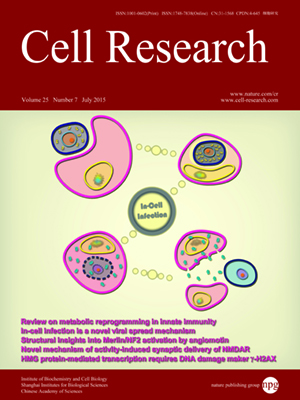
Volume 25, No 7, Jul 2015
ISSN: 1001-0602
EISSN: 1748-7838 2018
impact factor 17.848*
(Clarivate Analytics, 2019)
Volume 25 Issue 7, July 2015: 837-850
ORIGINAL ARTICLES
High mobility group protein-mediated transcription requires DNA damage marker γ-H2AX
Indrabahadur Singh1, Nihan Ozturk1, Julio Cordero1, Aditi Mehta1, Diya Hasan1, Claudia Cosentino2, Carlos Sebastian2, Marcus Krüger3, Mario Looso4, Gianni Carraro5, Saverio Bellusci6,9,10, Werner Seeger7,10, Thomas Braun8,10, Raul Mostoslavsky2 and Guillermo Barreto1,9,10
1LOEWE Research Group Lung Cancer Epigenetic, Max-Planck-Institute for Heart and Lung Research, Parkstrasse 1, 61231 Bad Nauheim, Germany
2The Massachusetts General Hospital Cancer Center, Harvard Medical School, Boston, MA 02118, USA
3Division of Biomolecular Mass Spectrometry, Max-Planck-Institute for Heart and Lung Research, Parkstrasse 1, 61231 Bad Nauheim, Germany
4Group of Bioinformatics, Max-Planck-Institute for Heart and Lung Research, Parkstrasse 1, 61231 Bad Nauheim, Germany
5Department of Medicine, Cedars-Sinai Medical Center, Los Angeles, CA 90048, USA
6Chair for Lung Matrix Remodeling, Excellence Cluster Cardio Pulmonary System, University Justus Liebig, 35932 Giessen, Germany
7Department of Lung Development and Remodeling, Max-Planck-Institute for Heart and Lung Research, Parkstrasse 1, 61231 Bad Nauheim, Germany
8Department of Cardiac Development and Remodeling, Max-Planck-Institute for Heart and Lung Research, Parkstrasse 1, 61231 Bad Nauheim, Germany
9Institute of Fundamental Medicine and Biology, Kazan (Volga Region) Federal University, 420008 Kazan, Russian Federation
10Member of the Universities of Giessen and Marburg Lung Center (UGMLC) and the German Center of Lung Research (Deutsches Zentrum für Lungenforschung, DZL)
Correspondence: Guillermo Barreto(guillermo.barreto@mpi-bn.mpg.de)
The eukaryotic genome is organized into chromatins, the physiological template for DNA-dependent processes including replication, recombination, repair, and transcription. Chromatin-mediated transcription regulation involves DNA methylation, chromatin remodeling, and histone modifications. However, chromatin also contains non-histone chromatin-associated proteins, of which the high-mobility group (HMG) proteins are the most abundant. Although it is known that HMG proteins induce structural changes of chromatin, the processes underlying transcription regulation by HMG proteins are poorly understood. Here we decipher the molecular mechanism of transcription regulation mediated by the HMG AT-hook 2 protein (HMGA2). We combined proteomic, ChIP-seq, and transcriptome data to show that HMGA2-induced transcription requires phosphorylation of the histone variant H2AX at S139 (H2AXS139ph; γ-H2AX) mediated by the protein kinase ataxia telangiectasia mutated (ATM). Furthermore, we demonstrate the biological relevance of this mechanism within the context of TGFβ1 signaling. The interplay between HMGA2, ATM, and H2AX is a novel mechanism of transcription initiation. Our results link H2AXS139ph to transcription, assigning a new function for this DNA damage marker. Controlled chromatin opening during transcription may involve intermediates with DNA breaks that may require mechanisms that ensure the integrity of the genome.
10.1038/cr.2015.67
FULL TEXT | PDF
Browse 2297


